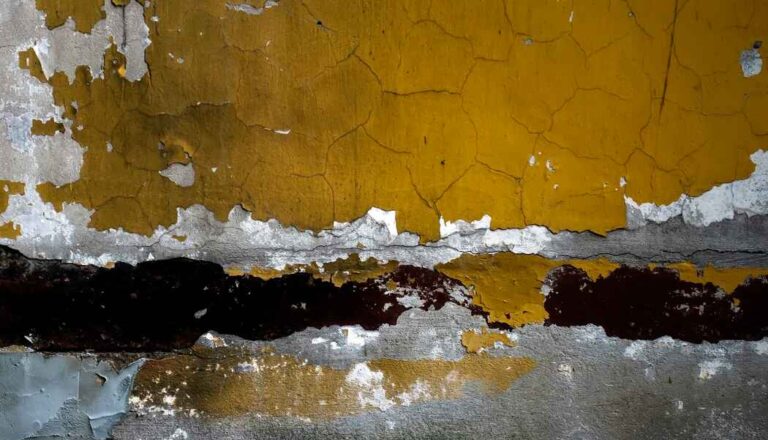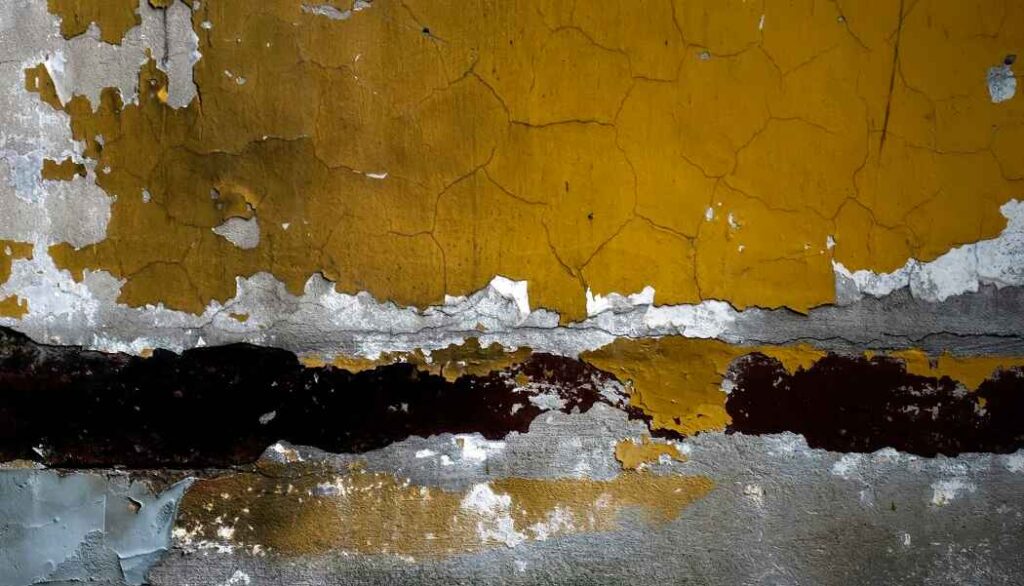
Can You Paint over Crackled Paint?
Yes, you can paint over crackled paint. But ensure the existing paint is stable. Remove loose paint and address underlying issues before painting for optimal results.

We are here to discuss about the causes of crackled paint, the importance of proper surface preparation, and the best practices for successfully painting over crackled surfaces.
So, Grab your brushes, and let’s take your DIY projects to new heights.
Can You Paint over Crackled Paint?
Absolutely, it is indeed possible to paint over crackled paint. But careful preparation and consideration of the underlying causes of cracking are essential to achieve a successful outcome.
Before painting over crackled paint, it’s essential to assess the condition and stability of the existing paint layers. If the crackled paint is loose, flaking, or peeling, it is necessary to remove it entirely to ensure proper adhesion of the new paint. Additionally, consider the type of paint used previously and its compatibility with the new paint. Incompatible paint layers may result in adhesion problems or an uneven appearance.
Begin by determining the extent of the crackling and evaluating the overall condition of the surface. If the crackling is minimal and limited to a few isolated areas, it may be feasible to proceed with painting over the crackled paint. If the crackling is extensive and covers a large portion of the surface, it might be necessary to consider other options, such as removing the existing paint and starting with a fresh surface.
Before painting, carefully inspect the existing surface for any underlying issues or damage. This includes examining the substrate for moisture damage, structural problems, or other signs of deterioration. Addressing these underlying issues is crucial before proceeding with any painting project, as they can significantly affect the durability and appearance of the new paint.
Once you’ve ensured that the surface is stable and in good condition, you can proceed with the painting process. Start by cleaning the surface thoroughly and sanding any rough or uneven areas. If there are remaining cracks or imperfections, consider using a suitable primer to create a smooth and uniform base for the new paint.
Choosing the right paint type is also vital for a successful outcome. Acrylic latex paints are generally recommended for painting over crackled paint, as they have good adhesion properties and flexibility, which can help prevent future cracking. Always follow the manufacturer’s instructions for the paint application, and consider applying multiple thin coats instead of a single thick coat.
How Do You Paint over Crackle Paint?
The process of painting over crackle paint, involves several steps to ensure a smooth and even finish. Here’s a detailed guide on how to paint over crackle paint:
1. Preparing the necessary materials:
- Drop cloths or plastic sheets
- Painter’s tape
- Sandpaper (medium grit)
- Tack cloth or a clean, lint-free cloth
- Primer
- Paint (latex or oil-based, depending on your preference)
- Paintbrushes or rollers
- Paint tray or bucket
- Stir sticks
- Optional: Paint sprayer
2. Protecting surrounding surfaces:
Remove any furniture or objects from the area you’ll be working on.
Cover the floor with drop cloths or plastic sheets to protect it from paint spills.
Use painter’s tape to mask off any adjacent surfaces or areas you don’t want to paint.
3. Cleaning the surface to remove dirt, dust, and loose paint chips:
- Start by preparing a bucket of warm water and mild detergent.
- After soaking a sponge or cloth in the soapy water, proceed to delicately scrub the crackled surface to ensure the removal of any dirt or grime.
- Pay special attention to areas with loose paint chips. Use a scraper or putty knife to carefully remove any flaking or peeling paint.
4. Repairing any major cracks, holes, or damage:
- Inspect the surface for any significant cracks, holes, or damage. Use a putty knife or a suitable filler compound to repair these areas.
- Follow the manufacturer’s instructions for the filler compound, ensuring proper application and drying time.
- Once the repairs have dried and cured, use sandpaper to smooth out the patched areas, making them flush with the surrounding surface.
5. Sanding the surface to create a smooth and even base for repainting:
- Use medium-grit sandpaper (around 120-150 grit) to sand the entire surface, including the crackled paint and repaired areas.
- Sand in a circular motion or back and forth, applying even pressure. This helps create a smooth and even base for the new paint to adhere to.
- After sanding, use a damp cloth to wipe away the dust generated during the sanding process. Allow the surface to dry completely before proceeding.
6. Priming the surface to improve adhesion and promote a consistent finish:
- Choose a high-quality primer (e.g., latex-based primer for latex paint, oil-based primer for oil-based paint) suitable for the type of surface you are working with (e.g., wood, metal, or plaster).
- Apply the primer evenly using a brush or roller, following the manufacturer’s instructions for drying time and coverage.
- Allow the primer to dry thoroughly before moving on to the next steps.
7. Painting over Crackled Paint
- Consider the type of surface you are painting (e.g., wood, metal, or drywall) and choose a paint that is suitable for that surface.
- If you want to replicate the crackling effect, consider using a crackle glaze or texture mediums specifically designed for this purpose. Otherwise, choose a regular paint for a smooth finish.
8. Applying the paint in thin, even coats to minimize the risk of crackling:
- Stir the paint thoroughly to ensure a consistent color and texture.
- Using a brush or roller, apply the paint in thin and even coats. Avoid overloading the brush or roller with paint, as this can lead to excessive thickness and potential crackling.
- Allow each coat to dry completely before applying the next one.
9. Considering the use of crackle glaze or texture mediums for intentional crackling effects:
- If you want to create intentional crackling effects, follow the manufacturer’s instructions for the crackle glaze or texture mediums.
- Apply the glaze or texture medium according to the instructions, and allow it to dry for the recommended time before proceeding with the next steps.
10. Allowing sufficient drying time between coats:
- Remove the painter’s tape carefully while the paint is still slightly tacky to avoid peeling.
- Allow the final coat of paint to dry completely before placing any objects back or using the painted surface.
If the crackle paint is in good condition and you want to maintain the crackling effect, you may choose to skip the repair and sanding steps mentioned in the preparation stage. Instead, you can focus on cleaning the surface and applying a suitable paint or glaze to enhance or refresh the crackling effect.
On the other hand, if the crackle paint is extensively damaged or if you want a smooth and even finish, following the detailed preparation steps, including repairing, sanding, and priming, will help create a solid foundation for the new paint.
Can You Paint over Cracked Chalk Paint?
Yes, you can paint over cracked chalk paint. Before proceeding, there are several important points to consider.
First, assess the extent of the cracking to determine the severity. Minor and shallow cracks can often be repaired, while deep or extensive cracking may require stripping the old paint entirely. Additionally, identifying the cause of the cracking is crucial in preventing similar issues in the future. Factors such as inadequate surface preparation, excessive paint layer thickness, or environmental conditions should be evaluated and addressed before repainting.
Choosing the right repair method is essential. Small cracks can be filled with a suitable filler, while larger cracks may require a patching compound or joint compound. Follow the instructions provided by the manufacturer of the chosen repair product for best results. To minimize the risk of future cracking, consider adding a flexible paint additive to the paint. These additives enhance the paint’s elasticity. It allows it to expand and contract with temperature and humidity changes without cracking.
Proper surface preparation is vital before repainting. Ensure that the surface is clean, dry, and free from any loose or flaking paint. Wash the surface to remove dust, dirt, or grease and allow it to dry completely before proceeding.
Conduct a small test patch in an inconspicuous area to test the paint compatibility. This helps ensure that the new paint adheres well and does not cause any adverse reactions or further cracking.
What Happens if You Paint over Cracking Paint?
If you paint over cracking paint without addressing the underlying issues, you may experience several problems that can affect the durability and appearance of the new paint job. Here’s what can happen:
Adhesion issues: Cracking paint indicates that the existing paint film is compromised and no longer adhering properly to the surface. When you paint over cracking paint, the new paint may not adhere well to the cracked surface, leading to poor adhesion. As a result, the new paint may begin to peel or flake off over time.
Visible cracks: Even with a fresh coat of paint, the underlying cracks are likely to reappear over time. The new paint may temporarily hide the cracks, but as the underlying layers continue to shift or expand, the cracks will eventually show through the new paint. It creates an unsightly appearance.
Uneven texture: Cracking paint can create an uneven surface with ridges and valleys. Painting over this uneven texture can highlight the imperfections, making the new paint job look uneven or bumpy. The cracks can also affect the smoothness of the finished surface, leading to an undesirable aesthetic result.
Trapped moisture: It can be an indication of moisture-related issues such as leaks, high humidity, or water damage. If you paint over cracking paint without addressing the moisture problem, the trapped moisture can continue to cause damage beneath the new paint. This can lead to further cracking, peeling, and even mold or mildew growth.
Worsened structural damage: Cracking paint can sometimes be a symptom of underlying structural issues such as settling, foundation problems, or excessive movement. Ignoring these underlying problems and simply painting over the cracking paint can allow the structural damage to worsen over time. The cracks may reappear and expand. It causes more significant issues with the paint and potentially affects the stability of the surface.
Final Words
Always take the time to diagnose and resolve any structural issues, coupled with meticulous preparation and quality materials. It will result in a successful transformation. So, with the right knowledge and techniques, you can confidently embark on your painting project.
